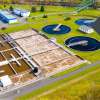16 May 2025
Water Conservation Series – Precision Manufacturing: Water Jet Cutting
When thinking of precision manufacturing, plasma or laser cutters often come to mind. However, water jet cutting, though it may seem like a modern innovation, has a surprisingly long history. Its roots date back to Roman times with records suggesting this method gained prominence in the 1850’s mining industry. Since its invention, water jet technology has advanced dramatically over the centuries.

Today, those advancements allow water to cut through thick materials using impressively high PSI pressures. Water jet cutting is a powerful and versatile tool in the manufacturing industry. In this blog, we will explore the cutting-edge technologies behind water jet systems, their advancements, and how they achieve precision without wasting water.
Waterjets and CNC Technology
A standard waterjet system consists of a water table, pumps, filters, sensors, and a computer system. At the heart of modern water jet cutting is Computer Numerical Control (CNC) technology. Widely used in the manufacturing industry, CNC systems operate tools like drills, lathes, grinders, and now water jets. These machines follow precise instructions that have been entered into the system, translating designs into accurate cuts with minimal hassle. Advanced sensors in the assembly detect marking points, allowing the system to follow complex patterns, much like a 3D printer.
A crucial component of the system is the pump, which increases water pressure from low PSI to the incredibly high PSI needed for cutting. An abrasive tank, containing materials such as sand, is pressurised and feeds the abrasive into an accumulation tank. Here abrasive mixes with the high-pressure water before being injected through the jet nozzle to cut materials.
To ensure optimal performance, the water passes through a series of filters and a softening system before entering the nozzle. These steps remove hard water minerals and impurities prolonging the system’s life and maintaining precision.
Advancement Through the Centuries
In the 1850’s, steam-powered water jets could achieve pressures of around 800 PSI. By the early 20th century, this pressure had doubled. In the 1930’s, water jet technology expanded beyond the mining industry into paper manufacturing. Early steam jet techniques were used to cut through paper, and soon after, abrasives were added to enhance cutting power.
The 1950’s marked a turning point, with advancements in engineering pushing water pressure up to 100,000 PSI - powerful enough to cut through stainless steel.
Pros and Cons
Precision and Clean Cuts: Water jet cutting eliminates the risks of inaccurate cuts, dust emissions, and burnt edges.
Exceptional Cutting Power: Capable of cutting through materials as thick as 9 inches or more.
Water Conservation: Operating on a closed-loop system, the water used during the cutting is recycled repeatedly, minimising waste.
Cold Cutting Process: Unlike plasma cutters or grinders that generate heat, water jet cutting uses a cold process. This makes it ideal for working with flammable materials, as well as stone, ceramics, and steel, without compromising structural integrity.
Maintenance Requirements: The abrasive or sand used in the process can build up over time. Maintaining water cleanliness can be time-consuming unless a sediment removal system is in place.
Safety Considerations: Safety is paramount when using a water jet cutter. The force of the water can reach speeds three times the speed of sound- approximately 3,701 km/h-making it potentially life-threatening if not handled properly.
To ensure a safe working environment:
- Wear protective gear.
- Ensure proper training.
- Inspect equipment regularly.
- Maintain a clear workspace.
- Establish emergency protocols.
By prioritising safety and adhering to these measures, water jet cutters can be operated effectively while protecting workers and the workplace.
If you are interested in precision manufacturing and minimising water waste, water jet cutting could be a practical solution for your workplace. For broader water conservation solutions, Orion Australia offers a wide range of water-saving products designed to suit various environments and applications.


